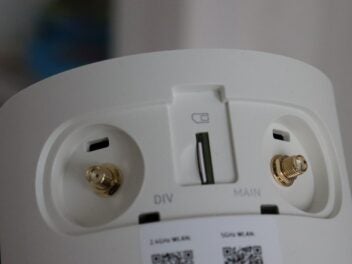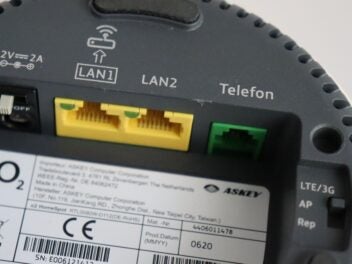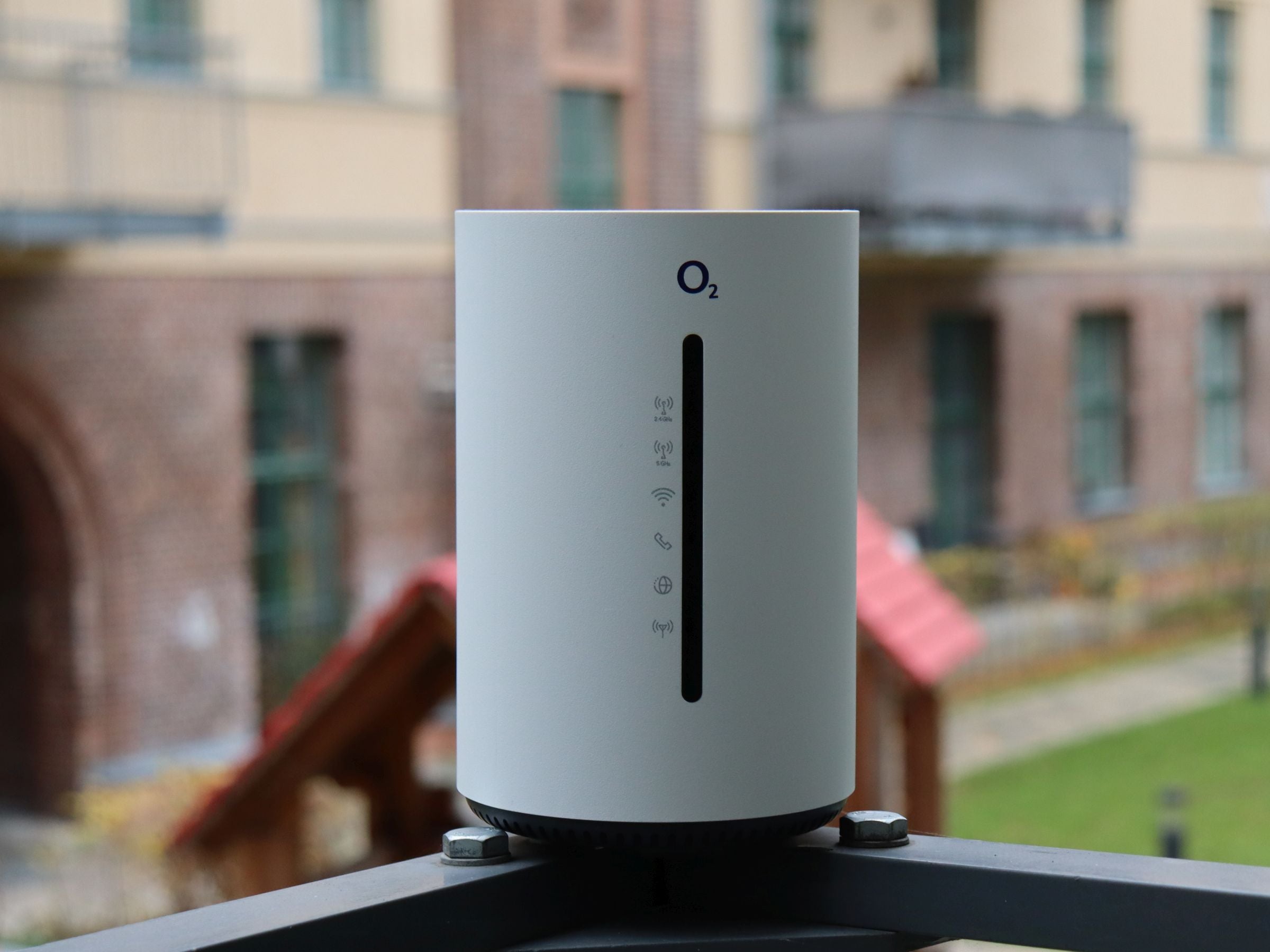The offer
Of the O₂ Homespot is a data flat rate via LTE with up to 50 Mbit / s in the downstream and 10 Mbit / s in the upstream. A telephone flat rate to the landline is also included – including landline number. As a two-year contract, access costs you monthly initially 19.99 euros (from 13th month 29.99 euros). One 10 Mbit / s version costs 5 euros less. Existing O₂ customers pay 10 euros less per month in both versions. Added to this are the costs for the router tested here. These are 4.99 euros per month. There are currently no connection costs. The only thing you need to get connected: an electrical outlet. No technician, no management.
The device
When the O₂ Homespot arrives at your home, one thing above all stands out: the construction of the router. While most internet routers are square and flat, the manufacturer of the O₂ Homespot has opted for a cylinder-like design. This makes it easier to place the router on a window sill – because that is the ideal location for cell phone reception. But speaking of manufacturers: the LTE router was manufactured in China by the rather unknown Taiwanese company Askey Computer Corporation. But don’t worry: you don’t have to speak Chinese or Taiwanese to use the router. The admin interface was completely adapted by O2 and is in German.
Overall, the router looks high quality and well made. The structure is also structured: on the back you will find two antenna connections and the SIM card slot under a flap. On the underside, the power connection and the input for two LAN cables are in a bulge. You can lead the cables out of the device through a bulge in the underside of the foot.
On the front you will find a row of LEDs that inform you about the status of the device. One LED each shows you whether WLAN is generally transmitting and, if so, on which of the two frequency bands. Another LED shows the quality of the LTE reception with different colors, another one whether you have a connection to the Internet. There is also an LED for a telephone function and a corresponding telephone socket on the underside. We didn’t test it because we used a SIM card for the test that was not primarily intended for the home spot (more about the free O₂ test card).
–
The commissioning
An instruction manual supplied by O₂ will guide you through the first steps with your new O₂ Homepot. We strongly advise you to follow the instructions because some steps are unexpected. For example, you need the SIM card in micro format and not in the nano format that is otherwise common in cell phones.
The O₂ Homespot also has slide switches on the underside that must be set correctly. If the setting is incorrect, the router does not work as an LTE modem, but as a repeater for existing WiFi networks.
It is positive that the instructions explain in great detail how to commission the router in a way that is understandable even for laypeople. Experienced users could, however, be tempted to simply skip the often long text and try it out for themselves.
It is also unexpected, for example, that the router’s WLAN transmits with two different SSIDs for 2.4 and 5 GHz. After restarting the router, it takes several minutes for the 5 GHz band to actually transmit. You can switch both frequencies on and off using a button on the back. You can also use the same button to activate the WPS function so that you can connect to the router without a password. To do this, you have to hold the button down for 3 seconds. But be careful: If you press the button too briefly, you will turn off the WiFi.

–
Commissioning the O₂ Homespot can be a bit exhausting if you cannot stand directly next to the router on the windowsill. Because the preset passwords for the WLAN and the admin interface are on stickers below the router and on the back. An additional insert in the form of a card would have been desirable here – but taking photos with the smartphone can do it if necessary.
The use
In our test household, unfortunately, the place at the window was actually the only one where we could test the O₂ home spot. The reception of the O₂ network in the test apartment is too poor – but this is also due to the construction of the house, with which the other networks also have their problems. But even with the window open, we achieved at best 20 Mbit / s, which is related to the moderate network expansion through O₂ in terms of capacity at our test location in Berlin. The cellular cell used supplies several hundred residents and a main road, but only has bands 3, 7 and 20. These are exactly the frequency bands that the Askey router supports. A future expansion through O₂ on other frequencies (such as the previous UMTS frequencies) will only benefit users of this router indirectly – namely by relocating other smartphones to the new frequencies.
In addition, the Homespot only supports LTE Cat 6 and can therefore only actively use two of the three possible frequency bands. If the reception signal is poor, you also have the option of connecting two external LTE antennas via SMA sockets. We couldn’t try this out in our test due to the lack of appropriate antennas. In rural areas in particular, such an outdoor or roof antenna could tip the scales. But be careful: The antenna should support at least one of the three frequency bands mentioned and the O₂ network on this frequency should also be available on your transmitter.
With WLAN, the O₂ Homespot supports WLAN 5 at 5 GHz and allows up to 64 devices at the same time. But more devices shouldn’t be attached to a home spot either. Devices that regularly generate a lot of stationary data traffic – such as a smart TV or a game console as well as a gaming or home office PC – should be connected using a LAN cable.
The power consumption should also be mentioned positively: it is 7.5 watts in standby with active WLAN. We didn’t get more than 10 watts of consumption in the test even under load. Assuming an average consumption of 8.5 watts, that adds up to around 75 kilowatt hours per year. Commercially available DSL routers do not consume less power, but rather more at their peak.

–
The admin menu offers all the functions one would expect. The structure is a bit illogical. All (!) Menu items can be found under the LTE / 3G mode submenu – which is also the only submenu of the main menu. You can use additional sub-menus to change your WiFi settings, view statistics on the connection and the data volume transferred, change routing settings for the home network (port sharing, IPv6 settings, domain filters) and switch between the two external antennas switch. It is also possible to send and receive SMS here.
The bottom line
There is nothing wrong with the O₂ Homespot, but its use depends on your local conditions. If your local O₂ network is chronically overloaded, weak or the wrong frequencies are in use, a fixed network replacement via the home spot shouldn’t be much fun. Our tip: Do a speed test beforehand with another O2 SIM card (for example the 30-day free card).
But if you have a good network, the O₂ Homespot is definitely a device that serves as a good basis for your home network. However, if you need several WiFi access points, you should switch WiFi off on the router and set up a new WiFi network using an external WiFi mesh set from any manufacturer.
It is a pity that at least the version we tested does not yet support 5G and is also limited in terms of frequency bands. Has O₂ already expanded 5G for you, but it is also available a 5G version of the Homespot.
Via our links
We use these symbols to mark affiliate or advertising links. If you click on a link or button marked in this way or use it to shop, we receive a small fee from the respective website operator. Don’t worry: this has no effect on the price of the product. But you are helping us to continue to offer inside digital free of charge and without a payment barrier. Thanks very much!
— –


